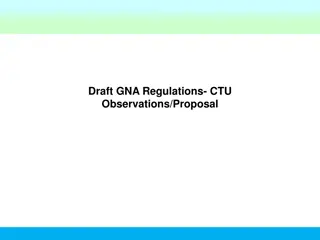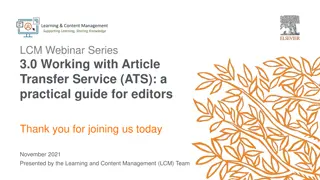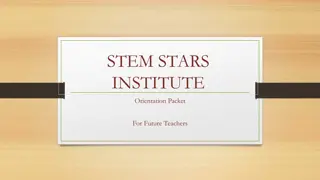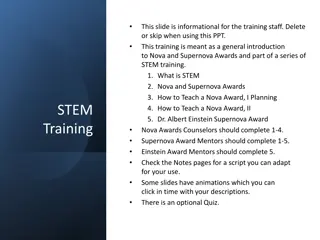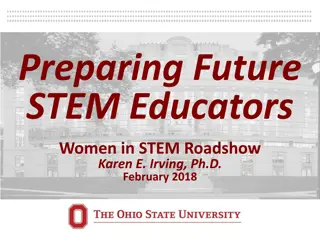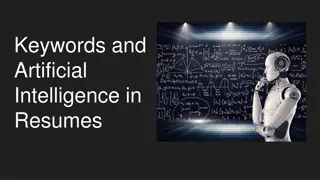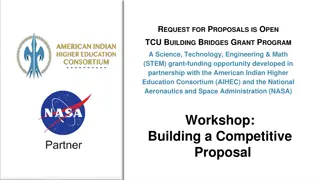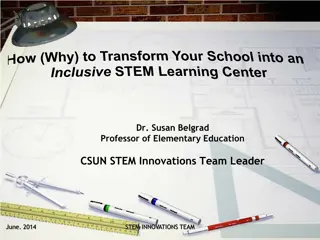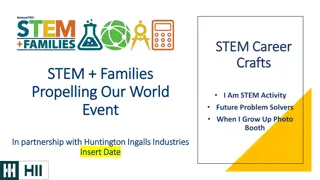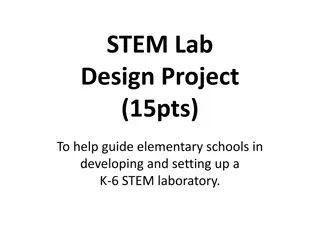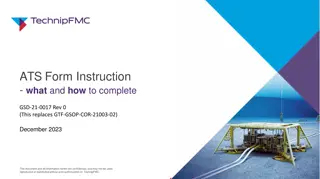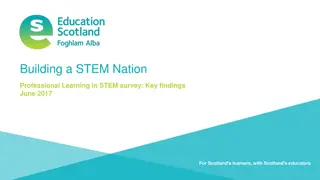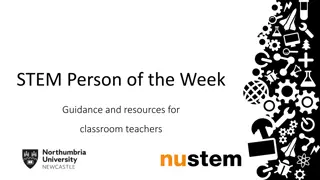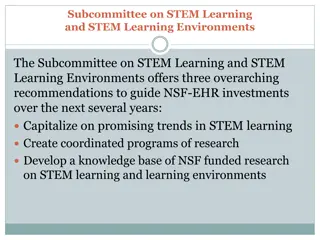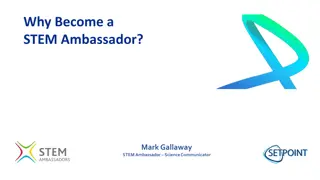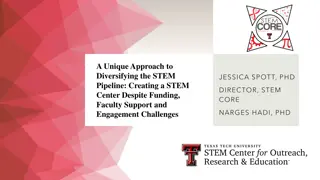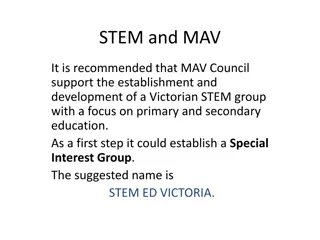A Comprehensive Overview of ATS STEM Framework for Teachers
Explore the ATS STEM framework for teachers, focusing on key principles like problem-solving design, disciplinary knowledge, and integrated STEM practices. Discover how to incorporate transversal competencies and formative assessments into STEM education, supported by real-world contexts and appropriate technology use. Embrace the importance of interdisciplinary connections and pedagogical practices in designing school-level implementations of ATS STEM.
Download Presentation

Please find below an Image/Link to download the presentation.
The content on the website is provided AS IS for your information and personal use only. It may not be sold, licensed, or shared on other websites without obtaining consent from the author. Download presentation by click this link. If you encounter any issues during the download, it is possible that the publisher has removed the file from their server.
E N D
Presentation Transcript
#ATSSTE M ATS STEM FRAMEWORK FOR TEACHERS WP 3
#ATSSTE M What will we be talking about in this material? 1. ATS STEM design principles 2. Transversal competencies 3. Formative assessment 1. Digital assessment tools 2. Integrated STEM
#ATSSTE M 1. ATS STEM design principles
#ATSSTE M 1. Problem Solving Design and Approaches 2. Disciplinary and Interdisciplinary Knowledge 3. Engineering Design and Practices 4. Appropriate Use and Application of Technology 5. Real-world Contexts 6. Appropriate Pedagogical Practices
#ATSSTE M Designing school level implementations of ATS STEM must follow all 6 of the principles presented in this chapter. These principles are embedded in the implementation template, but it is still beneficial to be aware of the following principles.
#ATSSTE M 1. Problem Solving Design and Approaches Integrated STEM should provide student experience activities that include problem solving through both developing solutions and inquiry. Teaching can be organised around problems and issues that are of personal and social significance in the real world. Problem solving design and approaches include the desire to apply prior learning and life experiences and the curiosity to look for opportunities to learn and develop in a variety of life contexts.
#ATSSTE M 2. Disciplinary and Interdisciplinary Knowledge Integrated STEM education should require students to apply knowledge of mathematics, technology, science and engineering, design and carry out investigations, analyse and interpret data, and communicate and work with multidisciplinary teams.
#ATSSTE M 2. Disciplinary and Interdisciplinary Knowledge The integration of knowledge areas involves obtaining a final product greater than the sum of its individual parts. Designing integrated experiences providing intentional and explicit support for students is important in order to build knowledge and skills both within the disciplines and across disciplines.
#ATSSTE M 2. Disciplinary and Interdisciplinary Knowledge Students knowledge in individual disciplines must be supported. Connecting ideas across disciplines is challenging if students have little or no understanding of the relevant ideas in the individual disciplines. However, students are often disinterested in science and math if they learn in an isolated and disjointed manner, missing connections to crosscutting concepts and real-world applications.
#ATSSTE M 2. Disciplinary and Interdisciplinary Knowledge Currently, crosscutting connections remain implicit or can be missing all together. These crosscutting concepts include patterns: cause and effect scale, proportion, and quantity systems and system models energy and matter structure and function, and stability and change.
#ATSSTE M 2. Disciplinary and Interdisciplinary Knowledge The complexities of STEM disciplines interrelationships are captured by the following: Science is both a body of knowledge that has been accumulated over time and a process scientific inquiry that generates new knowledge. Knowledge from science informs the engineering design process.
#ATSSTE M 2. Disciplinary and Interdisciplinary Knowledge The complexities of STEM disciplines interrelationships are captured by the following: Technology, while not a discipline in the strictest sense, comprises the entire system of people and organizations, knowledge, processes, and devices that go into creating and operating technological artifacts, as well as the artifacts themselves. Much of modern technology is a product of science and engineering, and technological tools are used in both fields.
#ATSSTE M 2. Disciplinary and Interdisciplinary Knowledge The complexities of STEM disciplines interrelationships are captured by the following: Engineering is both a body of knowledge about the design and creation of human- made products and a process for solving problems. Engineering utilizes concepts in science and mathematics as well as technological tools. As in science, knowledge in mathematics continues to grow, but unlike in science, knowledge in mathematics is not overturned, unless the foundational assumptions are transformed. Mathematics is used in science, engineering, and technology.
#ATSSTE M 2. Disciplinary and Interdisciplinary Knowledge During the knowledge construction process, the teacher s role is as a coach and facilitator rather than a dispenser of knowledge, as the focus is on problem-centred learning, inquiry- based learning, design-based learning, cooperative learning and other aspects, such as project-based and performance-based tasks.
#ATSSTE M 2. Disciplinary and Interdisciplinary Knowledge Making crosscutting STEM connections is complex and requires teachers to teach STEM content in deliberate ways so that students understand how STEM knowledge is applied to real-world problems. Crosscutting concepts provide students with connections and intellectual tools that are related across the differing areas of disciplinary content and can enrich their application of practices and their understanding of core ideas.
#ATSSTE M 2. Disciplinary and Interdisciplinary Knowledge Locating crosscutting practices will help students identify similarities in the nature of work conducted by scientists, technologists, engineers, and mathematicians, and could help students to make more informed decisions about STEM career pathways.
#ATSSTE M 3. Engineering Design and Practices Engineering design should be used as a catalyst to STEM learning. The model presented here will be utilised during the classroom application process. The steps followed during the engineering design process are: 1. Groups define the problem, which requires understanding the needs of the client and all of the task constraints. 2. Groups brainstorm potential solutions or solution methods and select an initial design.
#ATSSTE M 3. Engineering Design and Practices 3. Groups go through iterative cycles of building, testing and evaluating, and researching, which often leads to redesign. During the test and evaluate step(s), the task constraints are continually revisited to make sure that all the conditions have been met and that the solution adequately addresses the problem. 4. The final step in the process involves some form of public sharing of solutions and solution methods.
#ATSSTE M 4. Appropriate Use and Application of Technology During the STEM integration process, technology can either be viewed as a tool to facilitate teaching or a product or service produced as part of classroom practices. Some examples of technology use in the classroom practices include the use of simulations and 3D technologies, developing robots, virtual reality and programming.
#ATSSTE M 5. Real-world Contexts Connecting the discipline matter to real-life makes it more meaningful to students. Instead of being taught in a vacuum, disciplines should be brought to life through students needing to use it in order to solve real problems. The context for school level implementations in ATS STEM is the United Nations Sustainable Development Goals that direct action on the part of all nations towards improving life on our planet by 2030. Pilot schools are free to specify and define how they wish to approach this context.
#ATSSTE M
#ATSSTE M What: the goals of sustainable development. All goals are important and interconnected. In other words, one goal cannot be achieved without another. Who: Goals are relevant for all of us: countries, municipalities, businesses, schools, you and me. Everyone can participate with their choices and by disseminating information about the goals and by promoting political decision making as a way to a better future. Why: to make the world a better place for us all, acknowledging points of view of environment, human rights and economic.
#ATSSTE M ACTIVITY ACTIVITY AGENDA CARDS The ATS STEM teacher training material provides Agenda 2030 cards that include three cards for each goal. The first card presents a summary of the goal. The second card provides a short task related to the goal. It is possible to build a circuit activity with these cards. The third card presents a broader task related to the goal. The cards can be found here: bit.ly/agendacards
#ATSSTE M 6. Appropriate Pedagogical Practices A range of appropriate pedagogical and classroom practices can be applied, eg: Inquiry-based teaching method Project-based teaching method STEM-based modelling activities Teaching through instructional pedagogy Teaching through the engineering design process Using authentic learning activities
#ATSSTE M 6. Appropriate Pedagogical Practices A range of appropriate pedagogical and classroom practices can be applied, eg: Teaching with grade-appropriate materials and encompassing hands-on, minds-on, and collaborative approaches to learning Using appropriate technologies, such as modelling, simulation, and distance learning to enhance learning experiences and investigations Creating products and/or solving problems that can be made or solved using engineering principles
#ATSSTE M Checklist for STEM principles When designing an ATS STEM implementation, you do not have to acknowledge all the principles during each activity. However, you need to make sure that all boxes will be ticked during the two (or more) activities. Problem Solving Design and Approaches Disciplinary and Interdisciplinary Knowledge Engineering Design and Practices Appropriate Use and Application of Technology Real-world Contexts Appropriate Pedagogical Practices
#ATSSTE M 2. Transversal competencies
#ATSSTE M Collaboration Problem-Solving Creativity and innovation Critical thinking Discipline Knowledge and Skills Self-regulation Communication Metacognitive Skills
#ATSSTE M It is no longer a case of simply knowing some facts in a single domain and/or how to use tools in order to stay effective and competitive in an increasingly complex society. For future STEM careers, it is the competencies that students should develop in their schooling years that matter the most. It is broadly recognised that integrated STEM education allows students to develop a range of transversal competencies. A competence is a complex ability that is closely related to performance in real life situations. The European Commission defines competences as a combination of knowledge, skills and attitudes, stating that:
#ATSSTE M Knowledge is composed of the concepts, facts and figures, ideas and theories which are already established, and support the understanding of a certain area or discipline. Skills are defined as the ability to carry out processes and use the existing knowledge to achieve results. Attitudes describe the disposition and mind-set to act or react to ideas, persons or situations.
#ATSSTE M Collaboration Collaboration is the most frequently mentioned competence in integrated STEM education research. Collaboration refers to working with someone to produce something, and it can be linked to or have an impact on other skills and competences. There is increasing emphasis on the importance of learning to work collaboratively and productively with others in groups for participating effectively in society.
#ATSSTE M Collaboration Peer collaboration can help students be successful with challenging tasks and move beyond their current state of knowledge. Furthermore, working collaboratively and team learning, in a spirit of co-creation, enhances key competences essential for the 21st century and can lead to benefits that are greater than the sum derived from the constituent parts. It can support people becoming enthusiastic promoters of inquiry-oriented learning and portraying positive views of science.
#ATSSTE M Problem-Solving The second most frequently mentioned competency in integrated STEM education is problem-solving. Problem-solving can be defined as the process of finding solutions to difficult or complex issues. Integrated STEM should provide student experiences with activities that include problem solving through both developing solutions and inquiry. Teaching integrated STEM not only needs to focus on content knowledge but also to include problem-solving skills and inquiry- based instruction.
#ATSSTE M Problem-Solving Teaching can be organised around problems and issues that are of personal and social significance in the real world. Adopting such an approach not only develops students problem-solving skills; it also helps to integrate meaningful content and leverages their ability to contextualise concepts to real-life situations.
#ATSSTE M Creativity and innovation The third competence identified as being central to integrated STEM is creativity and innovation. Innovation is a highly interactive and multidisciplinary process and/or product that rarely occurs in isolation and is closely related to everyday life. Students of all ages should be inspired to be innovative and entrepreneurial in their approach to generating ideas and applying them to solving problems and helping develop sustainable responses to society s challenges.
#ATSSTE M Creativity and innovation Cultivating the development of creativity can help develop literacy, digital competence, entrepreneurship, cultural awareness and expression competence. For example, competence in cultural awareness and expression involves having an understanding of and respect for how ideas and meaning are creatively expressed and communicated in different cultures and through a range of arts and other cultural forms.
#ATSSTE M Critical thinking Critical-thinking is referred to in the studies as one of the core competencies as often as creativity and innovation. The importance of learning to think critically, to analyse and synthesise information in order to solve interdisciplinary problems is an important competence for participating effectively in society.
#ATSSTE M Discipline Knowledge and Skills Disciplinary knowledge and skills not only refers to each discipline in isolation but also the combination of these disciplines. Indeed, the European Commission considers STEM competence which includes knowledge, skills and attitudes of STEM disciplines as one of the core lifelong learning competences. Designing learning experiences for students that engage them in authentic, real-world design challenges enables the development of these core skills and disciplinary knowledge across and between the combined STEM disciplines.
#ATSSTE M Self-regulation Self-regulation refers to self-management and self-development, which includes the personal skills needed to work remotely, in virtual teams; to work autonomously; and to be self- motivating and self-monitoring.
#ATSSTE M Self-regulation One aspect of self-management is the willingness and ability to acquire new information and skills. In addition, social and emotional skills, such as empathy, self- awareness, respect for others and the ability to communicate, are becoming essential as classrooms and workplaces become more ethnically, culturally and linguistically diverse. It is noteworthy that these non-cognitive skills serve to promote the acquisition of cognitive skills early in a child's development but the relationship does not appear to be reciprocal.
#ATSSTE M Communication It is undeniable that communication is an inevitable part of our daily lives. It is not only an inevitable part of social relationships but also a significant part of work life success, as employers value the ability to communicate clearly and appropriately.
#ATSSTE M Communication A skilled communicator selects key pieces of a complex idea to express in words, sounds, and images as a way to build shared understanding. Skilled communicators negotiate positive outcomes with others through social perceptiveness, persuasion, negotiation, instruction, and service orientation. The importance of being able to communicate skilfully cannot be underestimated. In fact, as our classrooms and workplaces become more ethnically, culturally and linguistically diverse, the ability to communicate across these diverse populations is paramount.
#ATSSTE M Metacognitive Skills Metacognition is defined as the scientific study of an individual s cognitions about his or her own cognitions. Cognition is a mental process that includes memory, attention, producing and understanding language, reasoning, learning, problem-solving and decision making. It is often referred to as information processing, applying knowledge, and changing preferences. The development of metacognitive skills deserve greater attention when one considers that metacognition and emotions play a critical role in learners' ability to monitor and regulate their learning about 21st century skills related to STEM content.
#ATSSTE M ACTIVITY ACTIVITY ALIAS List the transversal competencies of your local curriculum. 1. Form groups of 4 teachers, and 2 pairs in each group. Each pair decides who is going to be the explainer and who the guesser. 2. The explaining teacher picks a competence and tries to explain to the guesser what teaching and developing that competence means and looks like in practice. 3. After 2 minutes, it is time to let the other pair try. The pair that guesses the most competencies correctly wins the game. The activity aims to disclose the thinking of teacher colleagues.
#ATSSTE M 3. Formative assessment
#ATSSTE M For formative assessment to be valid, it must lead to further learning. If a formative assessment does not support student learning, it cannot be said to be valid for its intended purpose. Thus, attention to student learning that occurs as a result of formative assessment is an essential part of the assessments validity. Given the importance of consequences for establishing validity in formative assessment, and the central role that feedback plays in formative assessment, a consideration of what constitutes effective feedback is warranted. Arguably, the only important thing about feedback is what learners do with it. While there is no way to guarantee that students will make use of feedback in a given situation, there are some forms of feedback that stand a greater chance of being effective than others.
#ATSSTE M Situating feedback Pay attention to articulating ultimate goals for students ( Feed Up ) Give students an indication of their progress ( Feed Back ) Show students where they should move to next ( Feed Forward ) Attention to the ultimate goal is essential when providing students with feedback. If feedback is not focused on advancing students progress towards goals, then it cannot be used to improve student learning.
#ATSSTE M Feedback categories Feedback about a specific task Feedback about a process Feedback related to self-regulation Feedback directed at the personal self. Feedback related to process and self-regulation is most helpful in advancing student learning. Limited task-oriented feedback may also be useful; however, feedback directed at the personal self is not helpful because it focuses on the student as a person rather than being directed towards the instructional goal (e.g., You did a great job! ).
#ATSSTE M Timing feedback Time is also an essential variable contributing to the use of feedback by students. Teachers must plan for and organise time both to provide feedback, and to help students to make sense of and use the feedback. If feedback is provided to a student, but the lesson immediately moves on, there is no real opportunity for the student to learn from the feedback that was provided.
#ATSSTE M Formative assessment as cyclical process Formative assessment is a cyclical process involving the elicitation of evidence, interpretation of evidence, and action based on that evidence. There are 5 strategies supporting this process: 1. Clarifying, sharing, and understanding learning intentions and criteria for success 2. Engineering classroom discussions, questions, and tasks that elicit evidence of learning 3. Providing feedback that moves learners forward 4. Activating students as instructional resources for one another 5. Activating students as owners of their own learning.












